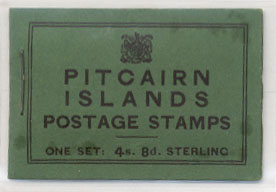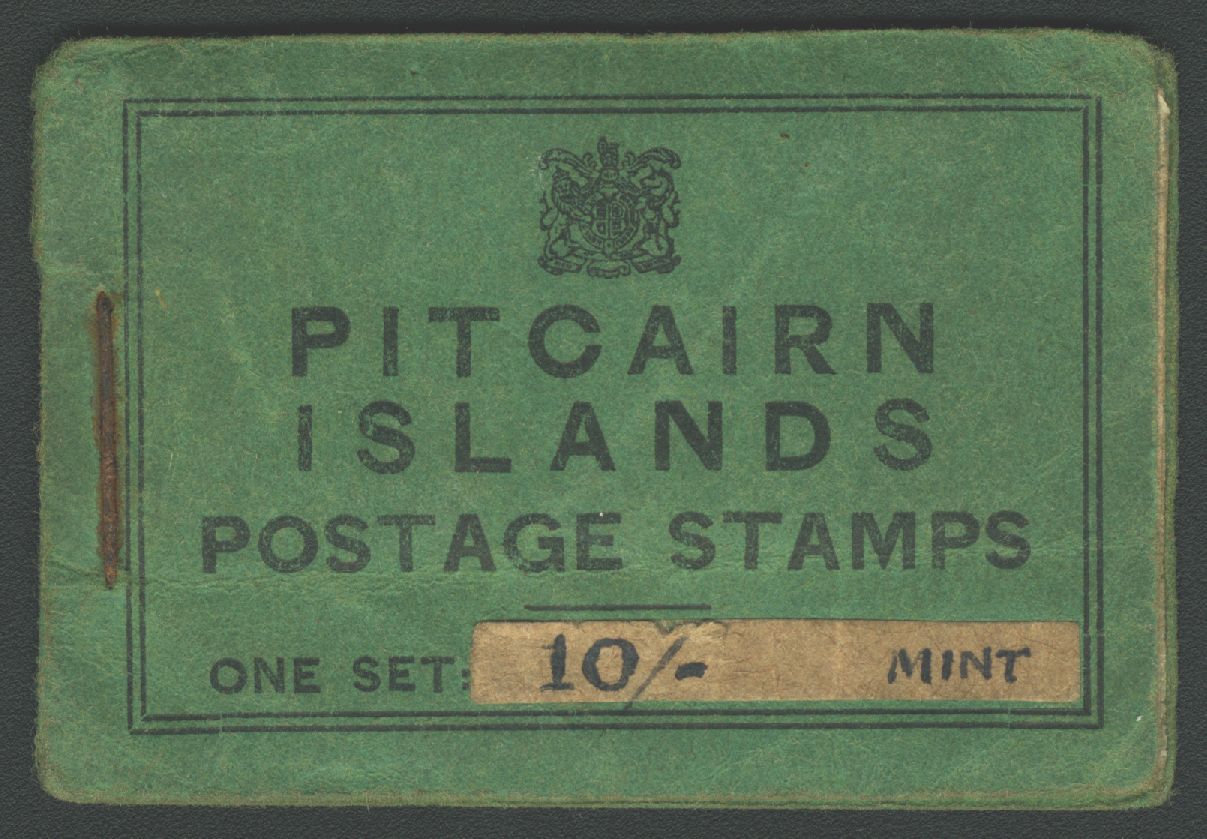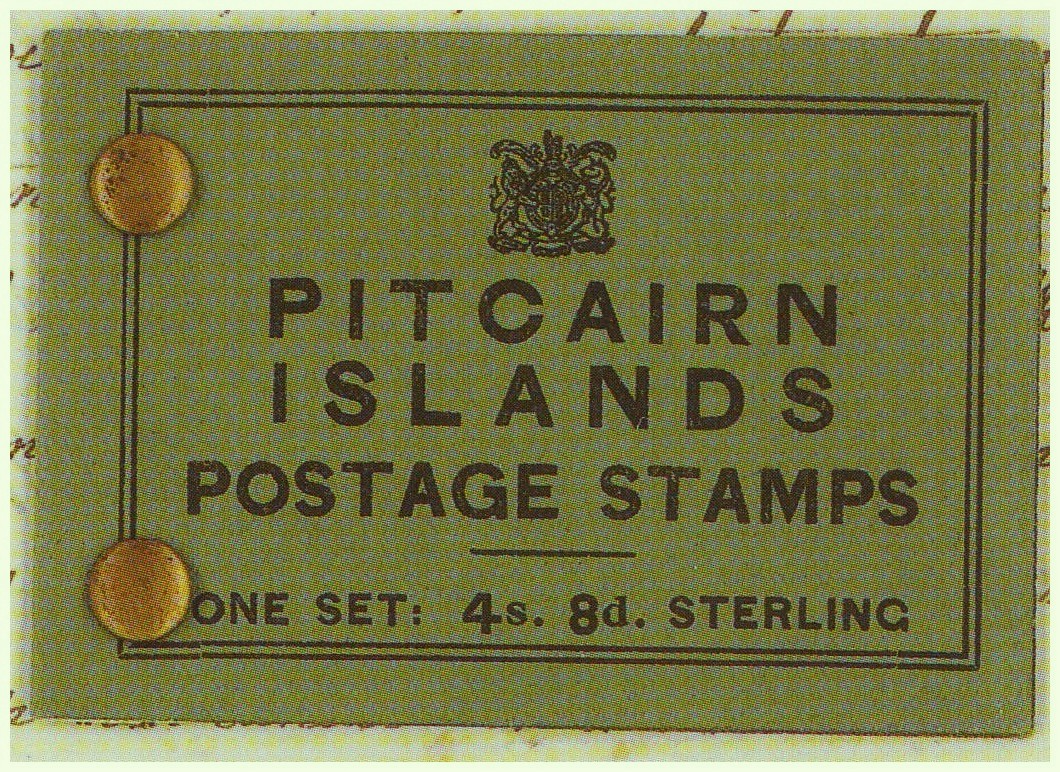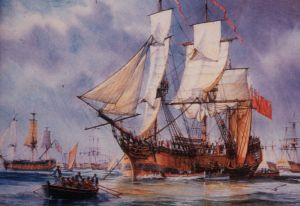Pitcairn Islands philatelic history is unique for several reasons. One of those reasons is that a stamp booklet was issued along with its very first stamps. Even the booklet itself is unique in that it does not have stamps printed as a booklet pane. Instead, the booklet contains one example of each stamp from the sheet stamps of the first definitive set.
Information presented here is a combination of what has been known and what has recently come to light about these booklets. This information will be used to update the description and classification in the Pitcairn Islands Specialized Stamp Catalog.
Sir Harry Luke, Governor of Fiji and High Commissioner for the Western Pacific, suggested the booklet idea so that it would be convenient for islanders to sell their first postage stamps to ship passengers. This is yet another unique aspect of this booklet and is due to the unusual socio-economic life of Pitcairn islanders.

Some 500 booklets were hand assembled on Fiji and delivered to Pitcairn with the supply of new stamps and the new Pitcairn Islands Post Office canceller. They were delivered by Mr. A. E. Fuller, a Fiji postal officer who also assisted with the opening of the Pitcairn post office and helped with the preparation of first day covers on October 15, 1940. Due to a number of factors affecting the assembly and use of the booklets, both at Fiji and Pitcairn, several varieties are now known to exist and this knowledge adds to the earlier information researched by Bill Hornadge.
Booklet covers were produced by the Fiji government printer and were used to assemble booklets at Suva, Fiji by the Fiji postal officials. Covers were printed on dark green stock with black text in one piece, then folded and stapled on the left side. They are 6.4 cm x 4.4 cm when folded and have a 1.7 cm staple. One stamp from each of the eight issues in the first definitive set was included in each booklet and brittle, brown wax paper separated each issue. Each stamp was from the left side of the sheet so that the selvedge allowed stapling without affecting the stamps. In this original configuration, each stamp faced the front of the booklet.
Apparently there was a shortage of stamp sheets at Fiji, especially the higher value stamps (since fewer of them were printed) and so the supply of left selvedge stamps ran out before the 500 booklets could be assembled. Right selvedge stamps were used in their place, with the result that these stamps face the back of the booklet. Most commonly, this involved the 2/6 stamp. Some booklets also received two staples rather than one.
Sales at Pitcairn were slow. Existence of the booklet was a local phenomenon known only at Fiji and Pitcairn. It seems that neither the Crown Agents nor collectors knew of the booklets. Since so few ships stopped at Pitcairn during these war years, there was little opportunity to sell the booklets, despite it being a great sales concept. Unlike the stamps and first day covers, the booklets were not marketed to collectors. Rather, they were strictly intended as convenient souvenirs for sale to ship passengers. When Mr. Fuller left to return to Fiji in January he noted that only 25 booklets had been sold during the October - December 1940 period.
Nevertheless, after a few years collectors became aware of this unusual philatelic item and orders poured in to the Postmaster at the time, Mr. Roy P. Clark. Since Fiji postal officials were not interested in producing more booklets, Mr. Clark sold those he had and then improvised. Demand seems to have been strong since it did not take long for the remaining 475 booklets to sell. Booklets beyond the original 500 and those reassembled from the originals are considered distinct from the Fiji assembled booklets since they were assembled by Mr. Clark and provide different characteristics.
In addition to the 500 Fiji assembled booklets originally sent to Pitcairn, an unknown number of extra covers were shipped as well. The existence of these extra covers was doubted for some time and they contributed to a mystery clouding the understanding of Mr. Clark’s improvised booklets. It has now been determined that there were extra covers and that Mr. Clark used them to create booklets. However, he also unassembled some of the original booklets since they were not selling well and he had more use of the stamps for mailing letters. These unassembled covers were reused to assemble new booklets. In addition, there doesn’t seem to have been any staples on the island, so Mr. Clark used brass fasteners instead. He also had the same problem with a shortage of left selvedge stamps, especially the 2/6 value. So, there are also Pitcairn assembled booklets with stamps facing the back of the booklet.
There have also been one or more enterprising islanders who applied a surcharge for delivering the booklets to ship passengers. They covered the original 4/8 price with a 10/- price using a piece of paper pasted over the original price on the cover. In addition, Mr. Clark sent some of the extra covers unused to collectors. Most of these were gratefully received by collectors and are still in collections, but some have been used to create fake booklets (which are easily distinguished from those assembled at Fiji and Pitcairn). With all of these variations in mind, the following classification has been developed.
Booklet Classification : BK1 / First Pitcairn Islands Booklet

BK1F / Original Fiji Island Post Office assembly. Booklet with one each of 1a-8a (first printing of first definitive set) using left selvedge stamps facing front of booklet. Dark green paper cover with black text folded at left (6.4 cm x 4.4 cm when folded). Brittle brown wax paper interleaving close to the size of the booklet. Staple (1 or 2) 1.7 cm.
- BK1Fa / Booklet as above but with 2/6 value using right selvedge and facing back of booklet (face down from the front).
- BK1Fb / Booklet as above but with several or all stamps using right selvedge and facing back of booklet (face down from the front).
- BK1Fc / Booklet as above but with a 10/- price on the front cover (rather than the original 4/8 price). This was hand written on a piece of paper pasted over the original price and served as a surcharge by an enterprising islander. Only three copies of this booklet are now known to exist.

BK1P / Improvised Pitcairn Islands assembly by Postmaster Roy P. Clark. Booklet with one each of 1-8 (first or later printings of first definitive set) using left selvedge stamps facing front of booklet. Dark green paper cover with black text folded at left (6.4 cm x 4.4 cm when folded). White wax paper interleaving smaller than size of booklet with each piece varying in size. Brass fastener having 1.0 cm pointed legs (1 or 2) used in place of staple.
- BK1Pa / Booklet as above but with 2/6 value using right selvedge and facing back of booklet (face down from the front).
- BK1Pb / Booklet as above but with several or all stamps using right selvedge and facing back of booklet (face down from the front).
BK1X / Extra non-Pitcairn Islands assembly created by unknown person using an original cover but with no wax paper interleaving and a smaller staple 1.1 cm. May be considered a forgery even though it uses an authentic cover.
- BK1Xa / Original cover unfolded, unstapled (no staple holes) and unused.
References
- David E. Gillis. Personal communication with information based on his Pitcairn Islands collection. 2006
- Bill Hornadge. "Research breakthrough - the 1940 booklet. " Pitcairn Log 4 (2/December): 4-9, 1976.
- Bill Hornadge. "The 1940 booklet. " IN: The Pitcairn Islands Stamp Catalogue. Bill Hornadge. Review Publications, Dubbo, Australia. 2nd rev. ed. 1981.
- William Volk. "The 1940 booklet of Pitcairn. " IN: Pitcairn Islands Philately: A Handbook with Collectors Checklist. David Hume. Protea Park, South Africa. 3rd rev. ed. 2006.

